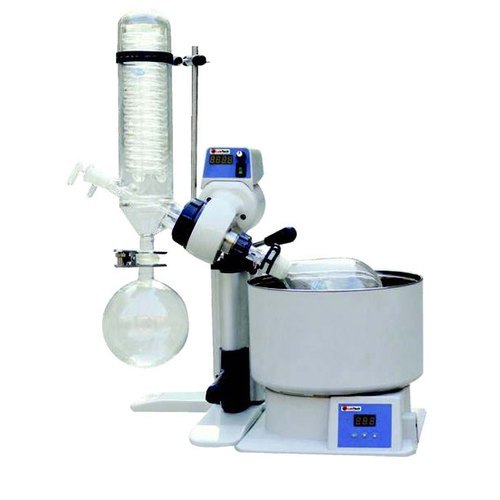The rotary evaporator mechanically rotates a flask containing the compound in solution in a hot water bath. The device is connected to a vacuum pump that reduces the high pressure of the bulk solvent, facilitating the separation of vapors from the sample, and the solvent evaporates until the compound remains. Water and solvent have a lower boiling point at reduced pressure, and therefore water and

The rotary evaporator mechanically rotates a flask containing the compound in solution in a hot water bath. The device is connected to a vacuum pump that reduces the high pressure of the bulk solvent, facilitating the separation of vapors from the sample, and the solvent evaporates until the compound remains. Water and solvent have a lower boiling point at reduced pressure, and therefore water and solvent can be evaporated or removed at a lower temperature.
The principle of operation of the laboratory rotary evaporator is that the boiling points of liquids are reduced by reducing their pressure, allowing solvents to evaporate at temperatures much lower than their boiling points at normal pressure. Also, its activity is in the form of vacuum distillation in a distillation flask with continuous rotation. Finally, after the gas phase has turned into a liquid, the extracted material goes into the receiver flask, which is easy for users to collect.
The evaporator works the opposite of the condenser. Here, the refrigerant liquid turns into gas and the absorbed heat is supplied from the air inside the chamber. This causes the condenser to quickly reach its low boiling point by absorbing heat from the hot air. The condenser evaporates by absorbing the maximum amount of heat. Watch the following video to understand this better:
The multiple rotary evaporator uses water vapor from one effect as a heating medium for the next effect, which operates at a lower boiling point. The latent heat in water vapor can also be reused by thermal or mechanical compression of the vapor at higher pressure and temperature.
The vacuum evaporation process involves reducing the internal pressure of the evaporation chamber below atmospheric pressure. This lowers the boiling point of liquids to evaporate. As a result, the need for heat in both boiling and condensation processes is reduced or completely eliminated.
A rotary evaporator or (rotavap / rotovap) is a device used in chemical laboratories to efficiently and gently remove solvents from samples by evaporation.
The main purpose of the rotary evaporator is to increase the evaporation rate of a solvent. It does this in three ways:
To install and operate Rotary, you must perform the following steps in order:
Condensers and flasks are available in uncoated glass for greater resistance to solvents and heat, and poly-coated for greater protection against breakage. Attached flasks and splash guard adapters will fit most brands of rotary evaporators.
When used as a condenser in a rotary evaporator, the cold ring can cool down to -78°C (dry ice) or even lower. Compared to water condensers that can cool down to minus 40 degrees Celsius (mixture of ethylene glycol and water), the lower temperature obtained can reduce the amount of volatile substances released into the air.

Between the steam tube and the evaporating flask on the rotary evaporator is used to prevent the contents of the flask from being drawn into the condenser during shaking. Traps have an external 24/40 top connection and an internal bottom connection with the listed sizes. Shock traps are available with plastic covers.
A rotary shock trap is used between the steam tube and the evaporating flask on a rotary evaporator to prevent the contents of the flask from being drawn into the condenser during shock. The modified teleshock trap provides a large volume for reactions that tend to foam too much.
Cleaning the exterior of the rotary evaporator is relatively simple. You can clean it with a damp cloth with water and mild detergent; But you should avoid using flammable cleaning materials (such as ethanol) outside the unit.
Note: Your RB flask should never be more than half full of liquid when you attach it to the rotary. If so, you risk losing some of your samples. If you have a lot of liquid to evaporate, take some until the flask is less than half full; Swirl the liquid in the RB and add the rest.
